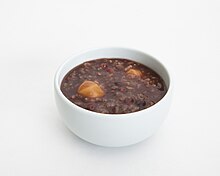Patjuk

A bowl of patjuk (red bean porridge) with saealsim (rice cake balls)
|
|
| Alternative names | Red bean porridge |
|---|---|
| Type | Juk |
| Place of origin | Korea |
| Associated national cuisine | Korean cuisine |
| Main ingredients | Red beans, rice |
| 58 kcal (243 kJ) | |
| Similar dishes | Hóngdòutāng, shiruko |
| Other information | Food related to dongji (winter solstice) |
| |
|
| Korean name | |
| Hangul | 팥죽 |
|---|---|
| Hanja | -粥 |
| Revised Romanization | patjuk |
| McCune–Reischauer | p'atchuk |
| IPA | [pʰat̚.t͈ɕuk̚] |
Patjuk (팥죽) or red bean porridge is a type of juk (Korean porridge) consisting of red beans and rice. The food is traditionally eaten on dongji (winter solstice).
Dried red beans are boiled with eight to ten parts water until fully cooked and soft, then mashed and passed through a sieve. The bean skins are discarded, and the remaining beans sit for some time in order for them to separate into layers. The upper layer consisting of clear water is used to boil rice, while the lower layer consisting of settled red bean mash is kept. When the rice is cooked, the mashed beans are added back into the porridge along with saealsim (새알심; literally "bird's egg", named as such due to its resemblance to small bird's eggs, possibly quail eggs), which are the small rice cake balls made of glutinous rice flour. The number of saealsim added is often the same number as the eater's age. Salt is then added to taste.
Patjuk is commonly eaten during the winter season, and is associated with dongji (winter solstice), the day with the shortest period of daylight and the longest night of the year.
Cooking and eating patjuk was also a ritual to prevent bad luck, epidemic disease, and influences from malevolent spirits. People believed that the red color of patjuk drives off baneful spirits, as red was a symbolic color of positive energy which can keep negative energy at bay. The beliefs perhaps originated from an old Chinese tale recorded in Jingchu suishiji, a 6th century book on seasonal customs of Jingchu. According to the story, a man named Gong Gong had a bad son who died on the day of winter solstice and became a disease-spreading evil spirit who was afraid of red bean porridge. People began to make red bean porridge on winter solstice to ward off the spirit, and forestall epidemic diseases. Before eating patjuk, Koreans used to offer it to various household deities such as kitchen god.Patjuk used to be smeared on walls or doors, or placed in a bowl in each room of the house.
...
Wikipedia
